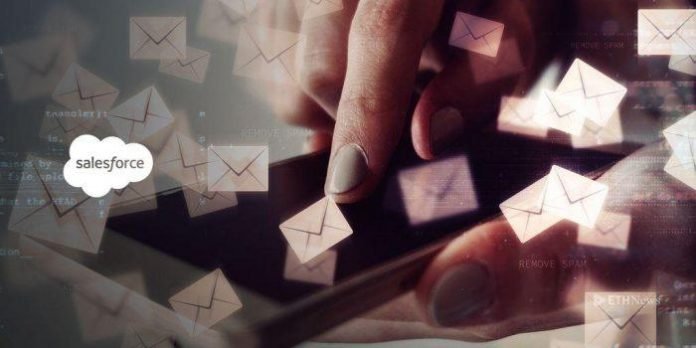November 7, 2018 10:31 PM
Salesforce wants spam to stay where it belongs – and to keep wanted emails out of the junk folder.
“Have you checked your spam folder?” You’ve probably said those words, or had them said to you, countless times, always in the same smiling and reassuring voice that carries with it an implied how-did-you-not-think-to-check-your-spam-folder-already judgmental undertone. Working to dispel this case of daily jargon ennui, cloud-based customer relationship management platform Salesforce recently received a patent to use blockchain-based technology to prevent legitimate emails from being sent to spam folders – and spam from mucking up users’ inboxes.
The patent, which was published by the US Patent and Trademark Office on November 6, outlines how the immutability of a blockchain can be utilized in a two-step process to verify the legitimacy of an email’s contents, ensuring that the message being received is correctly marked as unwanted/spam or sent through to the user’s inbox.
The patent details the low barrier of entry advertisers face when sending unsolicited bulk email messages – from virtually no operating costs to little in the way of recourse for spam recipients – which has helped lead to the massive volume of unsolicited messages. Despite most email services providing spam filters that are both automated and customizable, filters can still produce false positives (i.e., emails mistakenly marked as spam).
To improve the system, Salesforce would use a two-server delivery system that records portions of the message to ensure it has not been tampered with before reaching the inbox. The patent explains that once an email has been received by the first server, it:
“records at least one selected component of the received message into a block of the blockchain that is stored in the distributed database system. When the second message server receives the messages from the first message server, the second massage server can determine whether a component from the received message matches the selected component that is stored in the block of the blockchain. The disclosed embodiments can help ensure that messages and attachments to those messages have not been modified during transit over a network.”
Beyond improving how email is sorted, the patent briefly mentions that the technique could be used to authenticate “medical records, educational transcripts, deeds, property rights, legal documents, etc.”
Nicholas Ruggieri studied English with an emphasis in creative writing at the University of Nevada, Reno. When he’s not quoting Vines at anyone who’s willing to listen, you’ll find him listening to too many podcasts, reading too many books, and crocheting too many sweaters for his dogs, RT and Peterman.
Like what you read? Follow us on X @Bitnewsbot to receive the latest Salesforce, patent or other Ethereum application news.
Previous Articles:
- Study Says EOS Maxes Out At 250 Transactions Per Second
- Thai Revenue Department To Use Blockchain To Track Tax Payments
- Blockchain Wallet Provider Airdropping $125 Million In Stellar Lumens
- Daily Byte: Tuesday, November 6, 2018
- ConsenSys To Offer $500,000 In Grants To Fund Ethereum Infrastructure Projects

